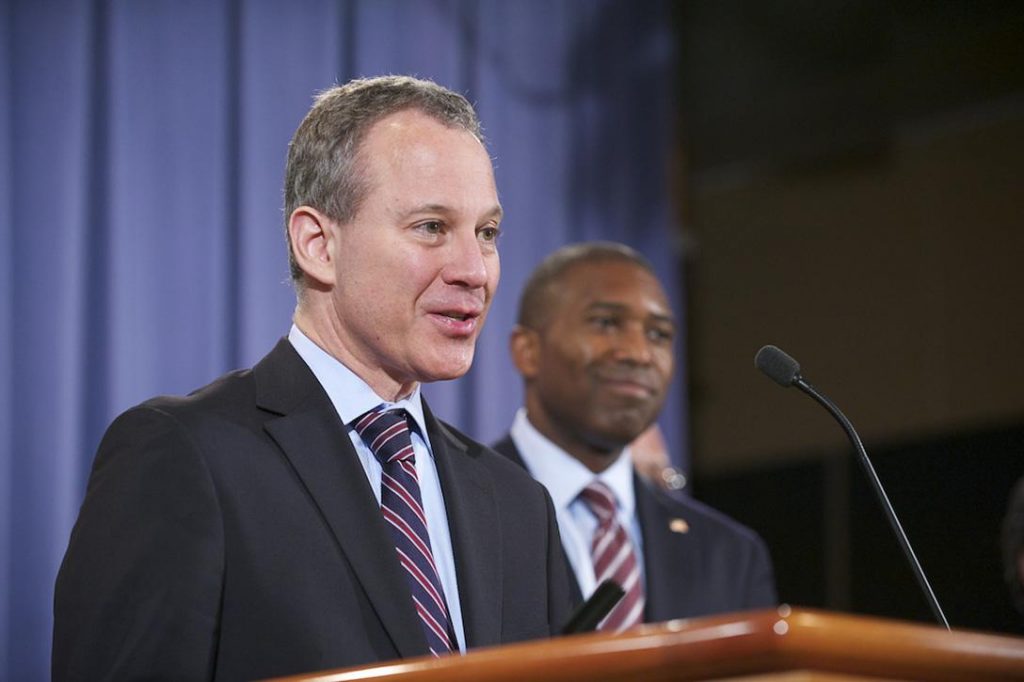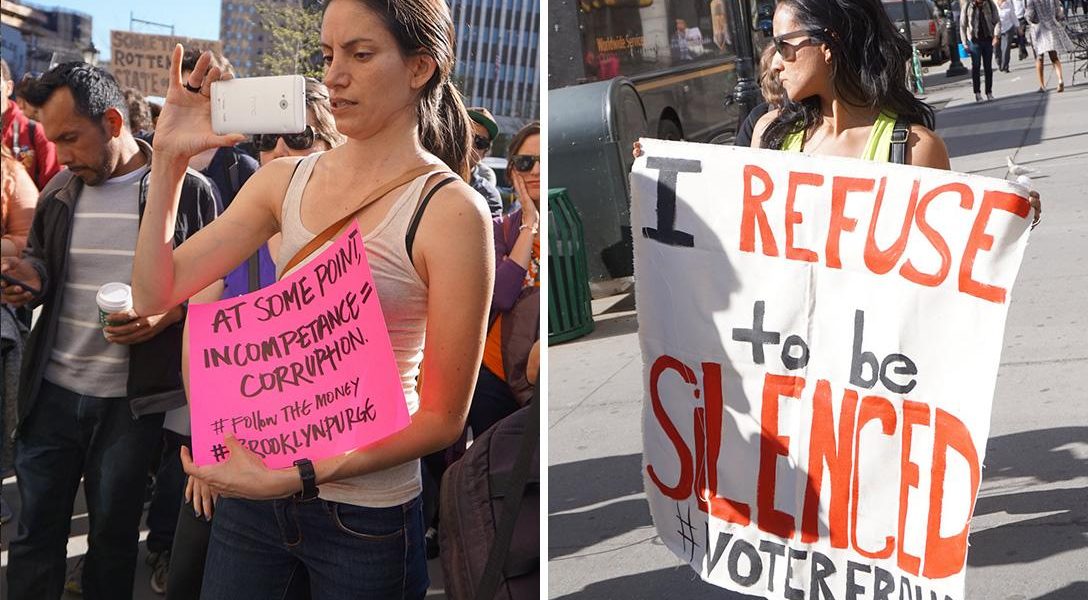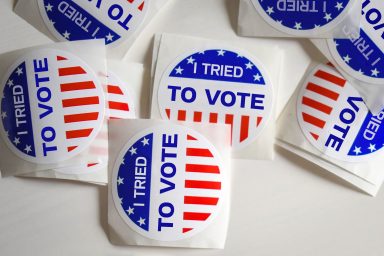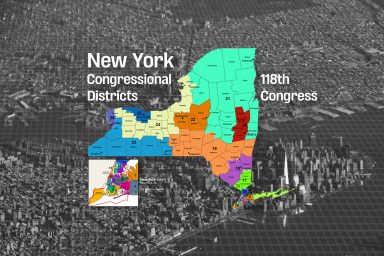Shortly after Hillary Clinton won the New York primary, the theory emerged that a Manhattan real estate deal could be tied to the purging of tens of thousands of Democratic voters from the rolls. We looked into the allegations and here is what we found.
WhoWhatWhy believes that when allegations are made about serious matters, journalists should investigate — and report what they find, and do not find. With your support, this will be the first of many such inquiries.
The New York Democratic Primary on April 19, 2016, was a mess.
In addition to strikingly onerous party registration rules which required people to file all the way back in October of 2015 if they wanted to change parties to vote in the closed primary, there were the long lines at polling places.
But the most egregious problems came when thousands of voters (including this reporter) found themselves stricken from the voter rolls when they tried to vote and were forced to sign affidavits they could only hope might be counted later.
With Hillary Clinton’s strong victory over fellow New Yorker Bernie Sanders having changed the momentum of the race that had begun to look much better for Sanders, there is ample reason for concern. With voting problems in a state so vital, there is good reason to look closer.
Shortly after the primary, the investigations started. New York’s flagship public radio station, WNYC, reported that tens of thousand of registered Democrats had been purged from the voter rolls. The New York State Attorney General opened an investigation into how that could have happened, and Diane Haslett-Rudiano, a Brooklyn county clerk working at the New York City Board of Elections, was soon suspended without pay.
Some Sanders supporters quickly noticed something suspicious about Diane Haslett-Rudiano. This was not the first time she had been in the New York City press. A few years before, a real estate deal had made her a multimillionaire, when she sold a severely dilapidated apartment building in Manhattan’s Upper West Side for $6.6 million, despite having only bought it for $5,000 in 1976.
Curiously, the buyer in that deal was Dana Lowey Luttway — the daughter of Nita Lowey, Democratic Congresswoman for New York’s 17th District, a strong ally of Hillary Clinton — and a superdelegate to the upcoming convention in Philadelphia.
All this begged a rather unsettling question: Was that real estate deal for 118 West 76th Street, giving a massive windfall in exchange for a property that was described at the time as “an ol’ bag of rats,” really just a front for a payment to a well-situated election official, who could, when the time was ripe, rig the election for Lowey’s ally Hillary Clinton?

New York State Attorney General Eric Schneiderman has opened an investigation into the New York primary. Photo credit: DOJ / Wikimedia
WhoWhatWhy investigated this question and dug deep into what happened to uncover the truth. Below are the results of our fact-finding mission, trying to ascertain what really happened to disenfranchised voters in the County of Kings.
A Staunch Clinton Ally
Nita Lowey came to Washington several years before the Clintons. She was elected to Congress first in 1989, and has served in the House ever since, representing parts of Westchester and Rockland counties, just north of New York City.
Since then, Lowey has become a close ally of Hillary. In 2000, the Clintons moved to Chappaqua, NY, right into Lowey’s district. Lowey considered running for Senate in 2000, but decided not to compete with Hillary Clinton, with whom she had become friendly during her time as First Lady.
Later, Lowey took herself out of the running for Clinton’s seat in 2009 since she was at that point a high ranking member of House Appropriations Committee, on which she is now the ranking Democrat.
Lowey supported Clinton in both 2008 (when the Huffington Post called her “the worst Clinton surrogate ever“) and 2016. She was one of the first to endorse Clinton, before the former first lady had even declared her candidacy. Lowey also lobbied the campaign to put its office in her district, before they decided on Brooklyn.
In the current Democratic primary, Lowey has shown herself to be one of Hillary Clinton’s most reliable supporters within the party. She introduced Clinton at several rallies in New York before the primary. When asked if she would switch her superdelegate vote if Bernie won the NY primary, her chief of staff said, “Absolutely not. Hillary Clinton is Congresswoman Lowey’s friend, colleague and her constituent, and she is behind her 100%.”
So in answer to the first part of this question, of whether Congresswoman Lowey had the kind of connection to Clinton to warrant this kind of suspicion, the answer is yes, Lowey is certainly a massive Hillary supporter.
But supporting Clinton is not evidence of anything but what seems to have been a long friendship from working together. Of course, it is worth looking into whether she has used that friendship for something corrupt.
Was it Really Suspicious?
.
If Lowey wanted to influence the election, would she really go through her daughter, considering the risk that would pose if she was caught?
Her daughter, Dana Lowey Luttway, is no stranger to the real estate market. She has had a reputation as a skilled house-flipper since 1984, owns her own real estate company and has pulled off multiple deals like this one.
WhoWhatWhy reached out to Luttway, who declined to discuss the 2014 deal.
The question then becomes the property itself. Did Luttway overpay Haslett-Rudiano for the brownstone she bought for so little and let fall into disrepair?
A June 2013 article from the New York Daily News (a year before the building was sold) suggested it would likely cost $5.5 million. Haslett-Rudiano expressed frequent refusal to sell, even as she received fines. It is currently listed for $18 million after major renovations.
WhoWhatWhy looked at similar townhouses listed on the market, and the renovated ones (as 118 West 76th Street is now) seem to be going in the high $7 million range today (which makes the current price absurd, but not the price in 2014).
The year 2014 was also in the middle of an “Upper West Side Boomlet,” according to The New York Times, with numerous properties in the area going for similar or even higher prices, and the market trends from Trulia suggest that prices were actually a little higher in 2014 than now.
At the time, there was seemingly a huge amount of pressure on Haslett-Rudiano to sell, including from neighbors, that NYDN article, and a “Save 118 W 76th Street” Facebook campaign. The West Side Spirit, in an article discussing the real estate deal, reported on personal appeals from City Councillor and eventual Manhattan Borough President Gale Brewer to Haslett-Rudiano, even as she refused to sell for sentimental reasons.
That West Side Spirit article contains what I felt was the best analysis of the process that went into eventually getting Haslett-Rudiano to sell. It includes this quote from the broker who made the deal:
“I’m very persistent,” said Mike Sieger, an associate broker with Fenwick Keats Real Estate who finally landed his personal Nemo. “I knew eventually she would sell, I just knew it.”
Sieger said he first contacted Haslett-Rudiano 20 years ago, when he was starting out in real estate. As for why she chose now to sell, and anointed Sieger to handle the transaction, he said, “I got her a very good price.”
Sieger said he’s considered giving up on Haslett-Rudiano throughout the years, but never did.
“I’m very pleased that I’m the broker that was able to succeed,” said Sieger. “Not only was I one of many, many brokers that called her, there were many, many buyers that were calling her and wanted to buy it cheap and wanted to buy it direct from her.”
Sieger declined to comment for this story.
Here is where my own personal opinion as a journalist must inevitably come into play. The short answer to the core question of this investigation, in my opinion, is no.
The brownstone did not seem to have been especially overpriced. While $6.6 million was higher than the original estimation of the Daily News, and significantly higher than the $1.5 million that Haslett-Rudiano briefly listed the property for in Spring 2013, it appears to be well within the bounds of what a buyer might pay to an owner who was holding out after numerous attempts to buy.
Haslett-Rudiano was apparently not willing to sell even with many offers. It seems unlikely she would take an offer that included such onerous additional requirements from her. It would essentially mean lowering the cost of the building itself.
Haslett-Rudiano’s position as the focal person of the New York primary mess is also in question. The New York Post suggests (somewhat convincingly) that the problem did not lie with her as she, a Republican appointee, oversaw the Republican voter rolls, not the Democratic ones. In the Post’s analysis, she was scapegoated. A few weeks later, her Democratic counterpart was similarly fired. Both of them seem to have bent the rules in their own favor all over the place.
The city investigated the board in 2013, and found widespread evidence of nepotism, bad hiring and review practices, and general incompetence and corruption. A closer look at the Board does not make the primary fiasco seem like an event that can be blamed on a single worker who was paid off.
The evidence does not point to the 2014 deal being so far out of the ordinary in terms of price that Haslett-Rudiano was making the kind of windfall that would be worth jeopardizing her job and helping get a Democrat elected, since she is, after all, a working member of the Republican party. She was making a $120k salary and had previously sold another multi-million dollar Upper West Side townhouse, and was already making a few million on this deal. It seems unlikely that she would take a bribe here.
Lowey has too much to lose in this kind of backroom deal for her involvement to make sense. This deal is on the books and was in the midst of high-profile media coverage from the New York press. Lowey is not just a sitting Congresswoman, but a rather high ranking one who has had her job since before the Clintons left Arkansas.
For her to funnel money through her daughter in such a public way seems like a bizarre thing for her to do in terms of risk. It does not seem like some large amount compared to how much the apartment would have been worth selling to someone else.
The NYBOE mess, and especially the involvement of Haslett-Rudiano, seems like a very inept way to rig an election in favor of Hillary Clinton. There was a purge of over 100,000 Democrats in Brooklyn, one of Hillary Clinton’s best areas.
It is especially hard to target specific types of voters in a one-party primary — the voter history does not line up the way it would in a general, since plenty of Democrats who did not support Clinton in 2008 do now, and vice versa. Clinton was projected to win New York before the election, and while she beat her polls by a few points, it is unclear how hypothetically removing voters from the rolls without knowing how they would vote would be the way to rig it.
The Verdict
.
I say all of this as someone who had to sign an affidavit to vote on April 19. I am shocked by how much of a mess the New York Primary was, but considering how much advocacy there has been on this for years, perhaps I should not have been so surprised.
But what that long history of terrible management by the Board says to me is that if Clinton really was behind the failure of the Board at the primary, this is a conspiracy so far-reaching that it has undermined the election process in Clinton’s home state for years.
Considering that New York is one one of the most heavily Democratic states in the country, and that, not knowing who she would be facing off against back in 2014, there was little reason to expect much difficulty for her here as a very popular former senator (who didn’t expect opposition from a guy with a thick Brooklyn accent), it seems like a very convoluted plan, not just in terms of the difficulty in pulling it off, but in terms of the badly targeted chaos in the election process of the nation’s largest city.
Obviously, we at WhoWhatWhy cannot conclusively say that no conversations between Dana Lowey Luttway and Diane Haslett-Rudiano about the sale of 118 West 76th Street related to Haslett-Rudiano’s position at the Board of Elections, or that the purge of voter rolls in advance of the primary was not done with an ulterior and specific motive.
But after digging into the sale, as well as the primary process, nothing suggests that the two were linked. We are left to conclude that the official narrative is most likely correct: The New York City Board of Elections has simply been abysmally managed.
Hopefully, the Attorney General’s investigation can begin to fix this problem.
Related front page panorama photo credit: Adapted by WhoWhatWhy from Manhattan and Brooklyn Bridge Xavier Gonzalo Pons / Flickr



